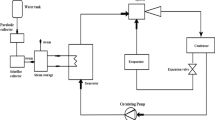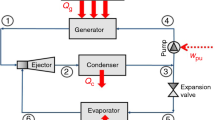Abstract
The objective of the work is to analyse and to improve the efficiency of solar-powered ejector refrigeration system integrated with flat-plate collector and Scheffler concentrator. The Scheffler concentrator of 2.7 m2 and flat-plate collector of 5 m2 collecting area are coupled with the storage tank of 15 l capacity. The developed system was designed for a potential replacement of conventional 1-ton room air conditioner with much reduced electrical energy consumption. The system was built based on two key subsystems namely ‘Scheffler concentrator-based vapour system’ and ‘ejector-based cooling system’. The pilot effort showed promising results with the probability of energy-saving potential as near 70 to 80% over conventional air conditioners.









Similar content being viewed by others
Data availability
The datasets used and analysed during the current study are available from the corresponding author on reasonable request.
References
Bellos E, Tzivanidis C (2017) Optimum design of a solar ejector refrigeration system for various operating scenarios. Energy Convers Manag 154:11–24. https://doi.org/10.1016/j.enconman.2017.10.057
Besagni G, Inzoli F (2017) Computational fluid-dynamics modeling of supersonic ejectors: screening of turbulence modeling approaches. Appl Therm Eng 117:122–144
Besagni G, Mereu R, Inzoli F (2016) Ejector refrigeration: a comprehensive review. Renew Sust Energ Rev 53:373–407
Bonafoni G, Capata R (2015) Proposed design procedure of a helical coil heat exchanger for an orc energy recovery system for vehicular application. Mechanics, Materials Science & Engineering Journal, Magnolithe. https://doi.org/10.13140/RG.2.1.2503.5282
Butrymowicz D, Bergander MJ, Smierciew K, Karwacki J (2010) Ejector-based air conditioner utilizing natural refrigerants. International Refrigeration and air conditioning conference at Purdue, pp 1–8
Chandak A, Somani SK, Dubey D (2009) Design, development and testing of multieffect distiller/evaporator using Scheffler solar concentrators. J Eng Sci Technol 4(3):315–321
Chen J, Havtun H, Palm B (2014) Screening of working fluids for the ejector refrigeration system. Int J Refrig 47(0):1–14. https://doi.org/10.1016/j.ijrefrig.2014.07.016
Chua KJ, Chou S, Yang WM (2010) Advances in heat pump systems: a review. Appl Energy 87(12):3611–3624
Chunnanond K, Aphornratana S (2004) Ejectors : applications in refrigeration technology. Renew Sust Energ Rev 8:129–155
Dafle VR, Shinde NN (2012) Design, development & performance evaluation of concentrating monoaxial Scheffler technology for water heating and low temperature industrial steam application. Int J Eng Res Appl 2(6):848–852
Dai Z, He Y, Huang Y, Tang L, Chen G (2012) Ejector performance of a pump-less ejector refrigeration system driven by solar thermal energy. International Refrigeration and Air Conditioning Conference at Purdue, pp 1-9
Elbel S, Lawrence N (2016) Review of recent developments in advanced ejector technology. Int J Refrig 62:1–18
Eldakamawy MH, Sorin MV, Brouillette M (2017) Energy and exergy investigation of ejector refrigeration systems using retrograde refrigerants. Int J Refrig 78:176–192. https://doi.org/10.1016/j.ijrefrig.2017.02.031
Ersoy HK, Yalcin S, Yapici R, Ozgoren M (2007) Performanceofasolarejectorcooling-system in the southern region of Turkey. Appl Energy 84:971–983
Fléchon J, Lazzarin R, Spinner B, Dicko M, Charters W, Kleinmeier H, Hammad MA (1999) Guild to solar refrigerators for remote areas and warm countries. International Institute of Refrigeration (IIR), Paris
Fu W, Li Y, Liu Z, Wu H, Wu T (2016) Numerical study for the influences of primary nozzle on steam ejector performance. Appl Therm Eng 106:1148–1156
Gil B, Kasperski J (2015) Efficiency analysis of alternative refrigerants for ejector cooling cycles. Energy Convers Manag 94:12–18
Haghparast P, Sorin MV, Nesreddine H (2018) The impact of internal ejector working characteristics and geometry on the performance of a refrigeration cycle. Energy 162:728–743. https://doi.org/10.1016/j.energy.2018.08.017
Hamzaoui M, Nesreddine H, Aidoun Z, Balistrou M (2018) Experimental study of a low grade heat driven ejector cooling system using the working fluid R245fa. Int J Refrig 86:388–400. https://doi.org/10.1016/j.ijrefrig.2017.11.018
Henning H-M (2004) Solar-assisted air-conditioning in buildings, a handbook for planners. Springer-Verlag, Wien
Huang BJ, Petrenko VA, Samofatov IY, Shchetinina NA (2001) Collector selection for solar ejector cooling system. Sol Energy 71:269–274
Jagveer Kumar D, Gupta T (2014) A solar powered air conditioning system for daytime offices based on ejector cycle: an alternate of conventional air conditioning systems. IJESRT 3(8):635–639
Kinjavdekar CA, Muley VP, Kedare SB, Nayak JK (2010) A test procedure for determining optical characteristics of a dish concentrator and its implementation on a Scheffler dish. Solar Energy Soc India 20(1 & 2):13–24
Li H, Cao F, Bu X, Wang L, Wang X (2014) Performance characteristics of R1234yf ejector expansion refrigeration cycle. Appl Energy 121:96–103
Liu F, Groll EA (2013) Study of ejector efficiencies in refrigeration cycles. Appl Therm Eng 52(2):360–370
Nayak B, Mandal BK (2014) Effect of generator, condenser and evaporator temperature on the performance of Ejector Refrigeration System (ERS). J Basic Appl Eng Res 1:4–9
Patil RJ, Awari GK, Singh MP (2011) Experimental analysis of Scheffler reflector water heater. Therm Sci 15(3):599–604
Pridasawas W, Lundqvist P (2004) An exergy analysis of a solar-driven ejector refrigeration system. Sol Energy 76:369–379
Rakeshsharma V, Bhosale SJ, Kedare SB, Nayak JK (2006) Field tests of the performance of paraboloid solar concentrator-ARUN160 at Latur. Proceedings of AER2006 - National Conference on Advances in Energy Research, Indian Institute of Technology -Bombay, December 4-5, p 182–187
Scheffler W (2006) Introduction to the revolutionary design of scheffler reflectors. International Conference on Solar cookers, Granada, Spain
Selvaraju AM (2003) Analysis of an ejector with environment friendly refrigerants. Appl Thermal Eng 43(9):915–921
Sumeru K, Nasution H, Ani FN (2012) A review on two-phase ejector as an expansion device in vapor compression refrigeration cycle. Renew Sust Energ Rev 16(7):4927–4937
Wang J, Dai Y, Sun Z (2009) A theoretical study on a novel combined power and ejector refrigeration cycle. Int J Refrig 32(6):1186–1194
Wu H, Liu Z, Han B, Li Y (2014) Numerical investigation of the influences of mixing chamber geometries on steam ejector performance. Desalination 353:15–20
Yan J, Cai W (2012) Area ratio effects to the performance of air-cooled ejector refrigeration cycle with R134a. Energy Convers Manag 53(1):240–246
Zhang H, Wang L, Jia L, Wang X (2018) Assessment and prediction of component efficiencies in supersonic ejector with friction losses. Appl Therm Eng 129:618–627. https://doi.org/10.1016/j.applthermaleng.2017.10.054
Zheng HF, Liang YH, Huang LY (2012) Analysis of entrainment ratio about solar ejector refrigerant system. Energy Procedia 16(Part A):516–521
Author information
Authors and Affiliations
Contributions
Conceptualization: Yuvarajan and Beemkumar; methodology: Yuvarajan and Beemkumar; formal analysis and investigation: Ganesan and Elangovan; writing—original draft preparation: Yuvarajan and Beemkumar; and writing—review and editing: Ganesan and Elangovan.
Corresponding author
Ethics declarations
Conflict of interest
The authors declare that they have no conflict of interest.
Ethical approval
Authors are attested that this paper has not been published elsewhere, the work has not been submitted simultaneously for publication elsewhere and the results presented in this work are true and not manipulated.
Consent to participate
All the individual participants involved in the study have received informed consent.
Consent to publish
The participant has consented to the submission of the study to the journal.
Additional information
Responsible editor: Philippe Garrigues
Publisher’s note
Springer Nature remains neutral with regard to jurisdictional claims in published maps and institutional affiliations.
Rights and permissions
About this article
Cite this article
Devarajan, Y., Nagappan, B., Subbiah, G. et al. Experimental investigation on solar-powered ejector refrigeration system integrated with different concentrators. Environ Sci Pollut Res 28, 16298–16307 (2021). https://doi.org/10.1007/s11356-020-12248-z
Received:
Accepted:
Published:
Issue Date:
DOI: https://doi.org/10.1007/s11356-020-12248-z




